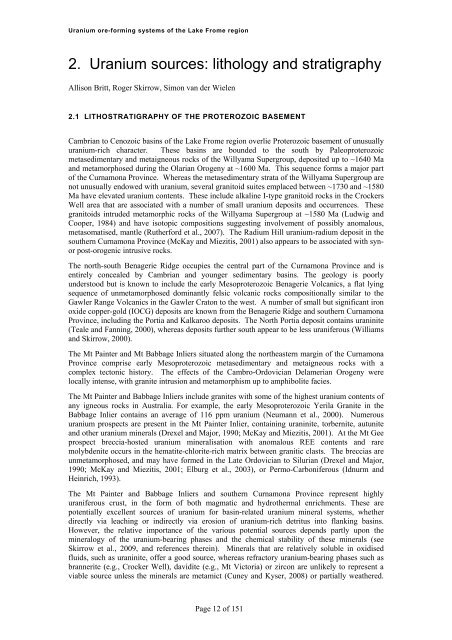Uranium ore-forming systems of the - Geoscience Australia
Uranium ore-forming systems of the - Geoscience Australia
Uranium ore-forming systems of the - Geoscience Australia
You also want an ePaper? Increase the reach of your titles
YUMPU automatically turns print PDFs into web optimized ePapers that Google loves.
<strong>Uranium</strong> <strong>ore</strong>-<strong>forming</strong> <strong>systems</strong> <strong>of</strong> <strong>the</strong> Lake Frome region2. <strong>Uranium</strong> sources: lithology and stratigraphyAllison Britt, Roger Skirrow, Simon van der Wielen2.1 LITHOSTRATIGRAPHY OF THE PROTEROZOIC BASEMENTCambrian to Cenozoic basins <strong>of</strong> <strong>the</strong> Lake Frome region overlie Proterozoic basement <strong>of</strong> unusuallyuranium-rich character. These basins are bounded to <strong>the</strong> south by Paleoproterozoicmetasedimentary and metaigneous rocks <strong>of</strong> <strong>the</strong> Willyama Supergroup, deposited up to ~1640 Maand metamorphosed during <strong>the</strong> Olarian Orogeny at ~1600 Ma. This sequence forms a major part<strong>of</strong> <strong>the</strong> Curnamona Province. Whereas <strong>the</strong> metasedimentary strata <strong>of</strong> <strong>the</strong> Willyama Supergroup arenot unusually endowed with uranium, several granitoid suites emplaced between ~1730 and ~1580Ma have elevated uranium contents. These include alkaline I-type granitoid rocks in <strong>the</strong> CrockersWell area that are associated with a number <strong>of</strong> small uranium deposits and occurrences. Thesegranitoids intruded metamorphic rocks <strong>of</strong> <strong>the</strong> Willyama Supergroup at ~1580 Ma (Ludwig andCooper, 1984) and have isotopic compositions suggesting involvement <strong>of</strong> possibly anomalous,metasomatised, mantle (Ru<strong>the</strong>rford et al., 2007). The Radium Hill uranium-radium deposit in <strong>the</strong>sou<strong>the</strong>rn Curnamona Province (McKay and Miezitis, 2001) also appears to be associated with synorpost-orogenic intrusive rocks.The north-south Benagerie Ridge occupies <strong>the</strong> central part <strong>of</strong> <strong>the</strong> Curnamona Province and isentirely concealed by Cambrian and younger sedimentary basins. The geology is poorlyunderstood but is known to include <strong>the</strong> early Mesoproterozoic Benagerie Volcanics, a flat lyingsequence <strong>of</strong> unmetamorphosed dominantly felsic volcanic rocks compositionally similar to <strong>the</strong>Gawler Range Volcanics in <strong>the</strong> Gawler Craton to <strong>the</strong> west. A number <strong>of</strong> small but significant ironoxide copper-gold (IOCG) deposits are known from <strong>the</strong> Benagerie Ridge and sou<strong>the</strong>rn CurnamonaProvince, including <strong>the</strong> Portia and Kalkaroo deposits. The North Portia deposit contains uraninite(Teale and Fanning, 2000), whereas deposits fur<strong>the</strong>r south appear to be less uraniferous (Williamsand Skirrow, 2000).The Mt Painter and Mt Babbage Inliers situated along <strong>the</strong> nor<strong>the</strong>astern margin <strong>of</strong> <strong>the</strong> CurnamonaProvince comprise early Mesoproterozoic metasedimentary and metaigneous rocks with acomplex tectonic history. The effects <strong>of</strong> <strong>the</strong> Cambro-Ordovician Delamerian Orogeny werelocally intense, with granite intrusion and metamorphism up to amphibolite facies.The Mt Painter and Babbage Inliers include granites with some <strong>of</strong> <strong>the</strong> highest uranium contents <strong>of</strong>any igneous rocks in <strong>Australia</strong>. For example, <strong>the</strong> early Mesoproterozoic Yerila Granite in <strong>the</strong>Babbage Inlier contains an average <strong>of</strong> 116 ppm uranium (Neumann et al., 2000). Numerousuranium prospects are present in <strong>the</strong> Mt Painter Inlier, containing uraninite, torbernite, autuniteand o<strong>the</strong>r uranium minerals (Drexel and Major, 1990; McKay and Miezitis, 2001). At <strong>the</strong> Mt Geeprospect breccia-hosted uranium mineralisation with anomalous REE contents and raremolybdenite occurs in <strong>the</strong> hematite-chlorite-rich matrix between granitic clasts. The breccias areunmetamorphosed, and may have formed in <strong>the</strong> Late Ordovician to Silurian (Drexel and Major,1990; McKay and Miezitis, 2001; Elburg et al., 2003), or Permo-Carboniferous (Idnurm andHeinrich, 1993).The Mt Painter and Babbage Inliers and sou<strong>the</strong>rn Curnamona Province represent highlyuraniferous crust, in <strong>the</strong> form <strong>of</strong> both magmatic and hydro<strong>the</strong>rmal enrichments. These arepotentially excellent sources <strong>of</strong> uranium for basin-related uranium mineral <strong>systems</strong>, whe<strong>the</strong>rdirectly via leaching or indirectly via erosion <strong>of</strong> uranium-rich detritus into flanking basins.However, <strong>the</strong> relative importance <strong>of</strong> <strong>the</strong> various potential sources depends partly upon <strong>the</strong>mineralogy <strong>of</strong> <strong>the</strong> uranium-bearing phases and <strong>the</strong> chemical stability <strong>of</strong> <strong>the</strong>se minerals (seeSkirrow et al., 2009, and references <strong>the</strong>rein). Minerals that are relatively soluble in oxidisedfluids, such as uraninite, <strong>of</strong>fer a good source, whereas refractory uranium-bearing phases such asbrannerite (e.g., Crocker Well), davidite (e.g., Mt Victoria) or zircon are unlikely to represent aviable source unless <strong>the</strong> minerals are metamict (Cuney and Kyser, 2008) or partially wea<strong>the</strong>red.Page 12 <strong>of</strong> 151
















